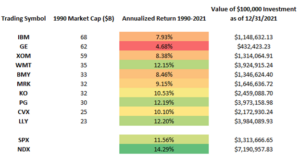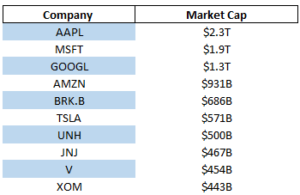Where Are Those “Top 10” Companies Now? – “Nineties” Focus
“Top” companies can seemingly do no wrong during their ascent. Whether filtered by top US companies by market cap or fastest growing over the last decade, these companies tend to be household names with a ton of caché. Right now, the top US company by market cap is Apple (AAPL). The fastest growing for the last decade (2010s) is Netflix (NFLX). Some of the luster has already caught up to Netflix as competitors have filled the gap. Apple, though, still seems to dominate. Will that be the case in five years? 10 years? When a fifty-something is ready to retire and dip into their nest-egg?
The only sure thing in investing is uncertainty, but maybe we can learn something from history. How have the “Apples” and “Netflixes” of the past performed over time? Today, let’s look back to 1990 and see if there are any important lessons for investors.
Below is a list of the ten largest companies by market capitalization as of the start of 1990[1], and their performance since. These return numbers include dividend reinvestment and consider a hypothetical $100,000 investment in each security on the close of trading for 1989[2]. The ending value is as of 12/31/2021. We’ve also provided information on the results of the S&P 500 Index (SPX), representing large-cap US equities, and the Nasdaq 100 Index (NDX), representing the 100 largest non-financial companies listed on the Nasdaq stock exchange, during the same period. While it’s not possible to invest directly in an index, index returns are widely used to reflect the performance of “markets” overall.
[1] As of the close of trading on 12/29/1989
[2] As of the close of trading on 12/29/1989

The hypothetical performance shown in the table above is for illustrative purposes only and is not intended to represent the performance of any Exceed Advisory portfolio or of Exceed as a firm.
What’s immediately evident is the underperformance by most of these companies versus the broad market. Only three of these ten stocks outperformed the S&P 500 over this 32-year period and the level of outperformance was very modest. Of the seven companies that underperformed the market during this time, only CVX and KO were able to produce dollar returns of at least half of what a similar hypothetical investment in the S&P 500 index would have produced. Annualized returns of only a few percent below the market may not seem like much on the surface, but the differences can be staggering when compounded over multiple decades.
Exxon Mobil Corp (XOM) is the only company on the list from 1990 that is also on today’s top-ten list. The oil giant is currently the tenth-largest U.S. company, with a market capitalization of about $443B. After underperforming for years, shares of XOM doubled from early 2020 to the end of 2021. The rally has continued this year as the Russia-Ukraine conflict rages on and puts upward pressure on energy prices. The pending global economic slowdown could potentially bring energy prices and equities under pressure, and any resolution or de-armament between Russia and Ukraine would likely lead to easing energy prices across the board. There are currently multiple risk factors that could reduce investment demand in XOM and bring its share price and market capitalization back closer to longer-term equilibrium levels.
So why did most of the largest ten companies underperform the broad market over this period? There’s obviously no explicit or simple answer, though multiple hypotheses may make a case for market efficiency. Perhaps this phenomenon is just the result of the dreaded “Law of large numbers.” Companies that achieve a certain size and level of market dominance eventually are capped by macroeconomic factors, and their growth rates normalize. The ten companies listed above weren’t built on fads or short-term economic trends, but many from the 2000s and 2010s were. Perhaps investors gravitated toward the newer “sexy” investments and shunned these present-day value names in hopes of achieving outsized returns. Economic trends have always been cyclical, and this creates boom and bust periods where a deemed great investment multiple years ago can become the exact place where you do not want to be invested when the tide goes out.
Below is the current list of the ten largest U.S. corporations. We will continue to look at different slices of time in future blogs as we did above, but the theme remains consistent – historically, most of the biggest companies have underperformed the broad market over long periods of time. It seems unfathomable that any of these companies could be poor investments going forward, but history suggests otherwise. That said, it’s also true that past performance isn’t a guarantee of future results, so we don’t know for sure what the future will bring. We do, though, think caution is warranted when assuming that today’s top performers will continue to be tomorrow’s top performers.

The solution to combat a concentrated portfolio of mega-cap stocks is simply to reduce position sizes and rebalance into a diversified market portfolio. Multiple studies have shown that concentrated portfolios often underperform over long time periods, and the optimal portfolio decision is to rebalance and reduce volatility and exposure.[3],[4],[5] If you or your clients have concentrated positions in any of the above companies, Exceed Investments can help. When executed properly, Exceed’s option tools can be implemented to hedge large investments, and in many cases reduce them to a desired level, often without having to pay capital gains tax. There are of course transaction costs involved, as well as advisory fees in the case of an options strategy, but the ability to exit these positions tax neutrally while also reducing portfolio volatility can have a substantial effect on long-term capital appreciation.
Contact us for a consultation.
IMPORTANT DISCLOSURE: The information in this blog is intended to be educational and does not constitute investment advice. Exceed Advisory offers investment advice only after entering into an advisory agreement and only after obtaining detailed information about the client’s individual needs and objectives.
[3] Nathan Sosner, “When Fortune Doesn’t Favor the Bold. Perils of Volatility for Wealth Growth and Preservation. The Journal of Wealth Management Winter 2022, jwm.2022.1.189; https://doi.org/10.3905/jwm.2022.1.189
[4] Bernt Arne Ødegard, “The diversification cost of large, concentrated equity stakes. How big is it? Is it justified?” Finance Research Letters Volume 6, Issue 2. https://doi.org/10.1016/j.frl.2009.01.003
[5] Baird’s Private Wealth Management Research, “The Hidden Cost of Holding a Concentrated Position. Why diversification can help to protect wealth.” https://www.bairdwealth.com/siteassets/pdfs/hidden-cost-holding-concentrated-position.pdf

